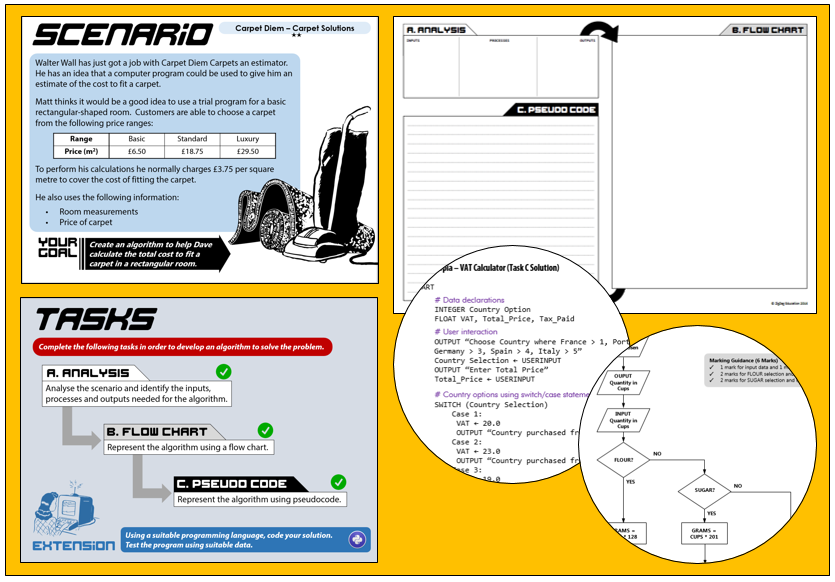Exercises in Computational Thinking
10 scenarios with tasks develop students’ understanding of abstraction, decomposition and algorithmic thinking. Perfect for use at KS4 level, including the new GCSE (9-1) Computer Science specifications!
Other resources I have used have been very focused on one or the other of these two areas, but this resource ensures that practical programming has a solid base in algorithm design.
For each scenario, students progress through the following tasks:
- Task A – analyse the problem and identify inputs, processes and outputs
- Tasks B and C – create visual representations of the problem using flow diagrams and pseudocode
- Extension – produce a coded solution using a suitable language
Facilitating lessons are visually engaging PowerPoints which include the scenarios, tasks and solutions (including Python3 code for the extension) all in one place!
Use as a standalone resource for problem solving/skills development, or as part of a PoS when teaching relevant topics as part of a curriculum. Each scenario has difficulty grading and skills cross-referencing to aid your planning.

What do teachers say about this resource? (5828)
Fantastic - what a time saver. It would have taken me months to create the problems/tasks in this resource. I have used them with Y9 and Y10. The quality of the resource is excellent. I spent hours searching the web for a resources like this. It takes you through the whole computational thinking cycle from problem, flowcharts, Pseudocode and students can then even create the python code as an extra challenge... Saves a huge amount of time. Perfect to get KS3 and KS4 students thinking about computational thinking. It can also be used for GCSE as an introduction to algorithms, flowcharts and Pseudocode.
Provides a varied set of tasks that help to test pupils ability to apply programs to real world situations. The structure of the exercises encourages students to design the algorithms to various challenges first, and then try and implement their algorithms with whichever programming language they know.
The tasks set help to build students ability to create both written and practical solutions to a wide variety of different programming style challenges.
The exercises have been a great help for setting homework that can then be followed up with practical programming tasks in lesson.
They help bridge the gap between the theoretical and practical elements of programming. Other resources I have used have been very focused on one or the other of these two areas, but this ensures that practical programming has a solid base in algorithm design.
My students have found the resources useful as they develop their Computational Thinking skills, and especially like the balance of having tasks that require both theoretical and practical solutions.
Nice activities... Allows students to stretch their minds and develop key skills for the course. A good match across multiple specs... Can be used for project based learning lessons, collaborative lesson activities and as cover work... I haven't come across a resource like it... Stuck for an idea for a lesson? Dip into this resource!